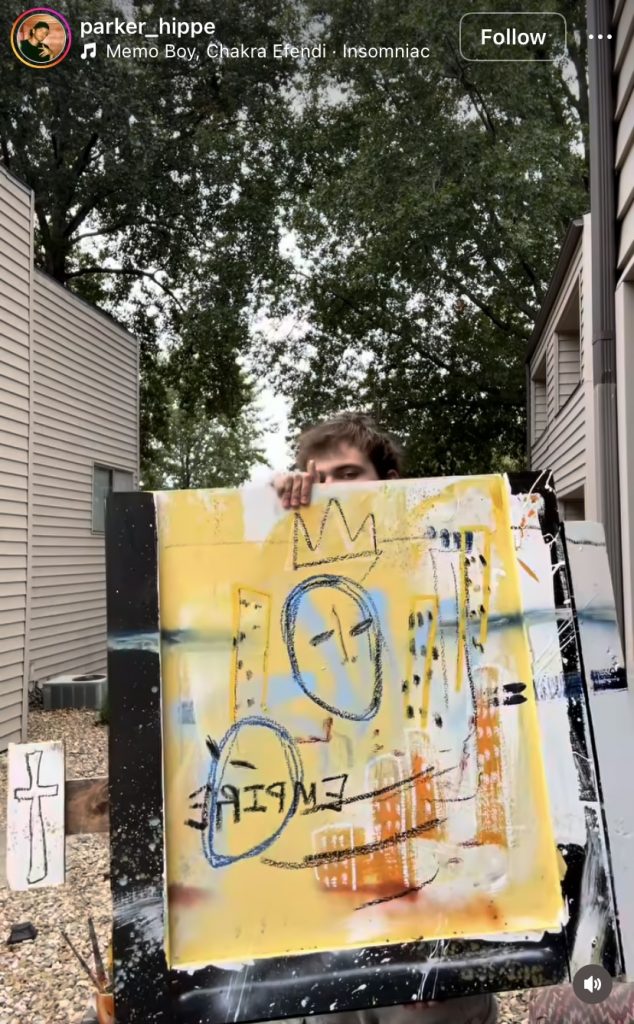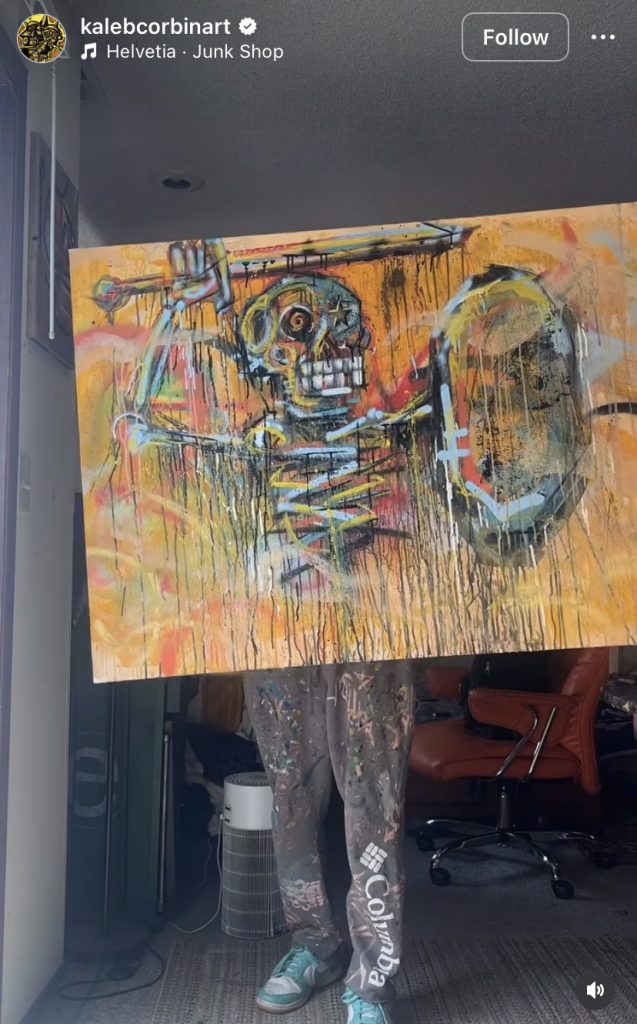One of the many advantages the internet has brought us is the accessibility of culture. Nowadays, there is no need to visit a museum or gallery to look at art. We can see it on the screen while lying under a warm blanket, which seems to be a great alternative for leaving the house on a cold, grey autumn afternoon like this. Of course, the experience will not be the same as a physical visit to an exhibition, but it is nice to have a choice. The development and popularity of social media platforms such as Instagram or TikTok have enabled artists to share their work and creative process with a broad audience online. Moreover, they provide visibility to anyone who makes art and wishes to share it. That means that whether one has a bachelor’s degree in Fine Arts and plenty of experience in the field or is a complete amateur with a passion for creating, the chances of getting the internet’s attention are similar. Quite often, that is determined by how well you can promote your art, whether you know what people like to look at, and how the algorithm works.
Copy and paste
Another way of gaining popularity as an artist is sparking a controversy. A good example would be a social media phenomenon I have been closely observing for a while now. Instagram and TikTok users are becoming frustrated with the videos posted by boys who persistently try to promote paintings that are quite obviously inspired by canvases of famous neo-expressionist Basquiat. The interesting aspect of that is how even though the comments the creators receive contain a multitude of accusations of copying the renowned artist and lacking originality, they don’t seem to get discouraged by that and keep uploading new posts. Despite the reputation they are gaining being rather negative, it still grants them a certain popularity, so why would they stop? Perhaps it is a way of remaining visible. I can imagine that, at some point, those guys will move on to new styles, and many people will support them unconditionally. The appreciation will most likely come with any attempts to express originality. The paintings will not even have to be good because anything will be considered better than creating feeble copies of Basquiat.


Luckily, taking as radical steps as the Basquiat clones is not essential to becoming an artist recognized online. The creators who cherish authenticity and stand against plagiarism also gain followers because oftentimes, all it takes is to be good at your craft and to share interesting ideas. Moreover, this way, you attract people who truly respect your practice instead of ones who are only invested in the drama. However, it is difficult to start gathering your audience therefore, promoting art online as an emerging artist can lead to many frustrations. Nevertheless, this can easily be changed if a bigger content creator notices you and features your work in their posts. Weopen is an artist and a self-proclaimed internet art critic who started a series of Instagram reels in which he comments on the art of his followers. The idea turned out to be a great success, so the creator not only gained numerous new followers but had to face the challenge of figuring out a way to choose from the multitude of people eager to get their art evaluated. That’s why now if you’re interested in his critique, you are required to pay a small fee. I find Weopen’s online activity incredibly beneficial for the online art community. Firstly, due to his rise in popularity, each of the videos reaches a huge audience, which provides visibility to all the emerging artists he mentions. By coming across his Instagram page, I became familiar with many inspiring creatives I would have never discovered myself. Other than that, his feedback and opinions are very constructive, allowing people to look at their art from a new perspective and develop further in their practice. Lastly, he created an online platform for art discussions where everyone can freely express their views and give input on the topic.
The digital on canvas
To finish this blog, I want to talk about my observations on how the internet culture impacts the development of traditional art mediums like painting. I often use the internet to look at art, so I quickly notice specific trends that emerge in the art world. Because nowadays, almost every artist shares their works online, the pace of creation of such trends has highly increased. One of the tendencies in painting that I suspect became so common mostly due to its popularity on social media is using the airbrush technique.
Although I like the blurred effect and find many of the paintings done in this way interesting, I realized a lot of them look quite similar. This is linked to the fact that besides the usage of the same method of painting, the theme of those artworks usually connects with the digital realm. Very often, that imagery is inspired by old computer game graphics, references memes, or is created in a way that mimics a digital drawing. My intention is not to criticize artists who fall into the trend but rather to question how many of those artworks are created as a result of the genuine interest of their maker and how many of them are made because it is something accessible and liked by a general audience due to its use of popular media elements and is it something that is going to last.








I really appreciate how you’ve explored the impact of social media on art, both the positive and negative aspects. I agree that while social media has made art more accessible, it has also lowered its overall quality. The algorithm now plays a huge role in shaping what gets attention, often prioritizing trends over originality. Many people follow what’s popular based on likes and views, assuming it must be good, which can overshadow genuine creativity. Your example of the Basquiat-inspired works shows how controversy can drive attention, even if it’s negative. This makes it harder for authentic artists to stand out. It’s great that creators like Weopen are helping emerging artists gain visibility through constructive feedback! It’s interesting to consider how much of today’s art discourse is shaped by algorithms rather than by scholars or artists themselves. It’ll be fascinating to see how these digital art trends evolve in the future.
Thank you for such an interesting read! I also love to explore art through the internet, and I’m grateful I have access to so many talented artists’ creative works. However, I do notice some dominance of trends over actual creativity, as well as many similarities across different works, and often find myself stuck in yet another bubble curated just for me by my latest preferences and of course the invisible hands of the algorithm. Sometimes that makes me feel disinterested and kind of unmotivated towards art exploration; it’s easy to perceive what we see as all there is out there.
A completely new topic for me but thank you for such an easy and interesting introduction! Above all, I’ve never seen such digital motifs on traditional canvases or anything like that. I don’t think I’m the biggest fan of this, but Weopen now has a new follower.
But what I generally find interesting here is the impact that digital media has on the fact that everyone is now able to create and distribute content, regardless of their qualifications. Of course, this makes the art world much more inclusive, but it also creates a whole new situation in which the trend of copying other artists becomes possible, or other. It’s a very relevant area of tension that occurs in this way not only in the field of art, but also in news distribution, opinion-forming and much more… I don’t know how we’ll deal with it in the future
I really enjoyed reading your post—it gave me a lot to think about! The way you described how digital culture has reshaped the art world is so on point. It’s amazing how accessible art is now, but it’s definitely a double-edged sword. On one side, it’s great that anyone can share their work and find an audience, but on the other, it feels like artists are under so much pressure to cater to algorithms or jump on trends just to stay visible.
The whole Basquiat-inspired phenomenon you mentioned is such an interesting example of this. It’s wild how much attention people can get—positive or negative—just by stirring up some controversy. I feel like it says a lot about how online art communities balance originality and marketing. It’s frustrating, but at the same time, it’s almost a strategy to stay relevant, which is kind of sad when you think about it.
Really like your post! It raises an important point about the prevalence of homogenous styles in online digital art, which seems closely tied to the influence of algorithms and popular trends on platforms like Instagram. While this accessibility fosters community and makes digital art more approachable, it can also discourage risk-taking and individual creativity, as many artists feel pressured to conform to what “sells” or gains traction online. How do you think artists might break out of these stylistic molds while still staying engaging with an online audience?
I really loved reading your post. Currently I make art but just for me, I don’t post it on the internet or anything (I used to but never really used my art account so I deleted in). The different perspectives are very interesting to learn about and to see what are the possible negatives and positives of being an artist in digital times. I never delved deep into the fact that the digital world has influenced and shaped the art world so much but it does make a lot of sense. It is obviously all up to the algorithm what will do well and what won’t so some artists might be changing their art style to gain more popularity which is an interesting thing to think about. Weopen sounds like an awesome person that offers a lot of good to the art world. I’ll be definitely looking them up!